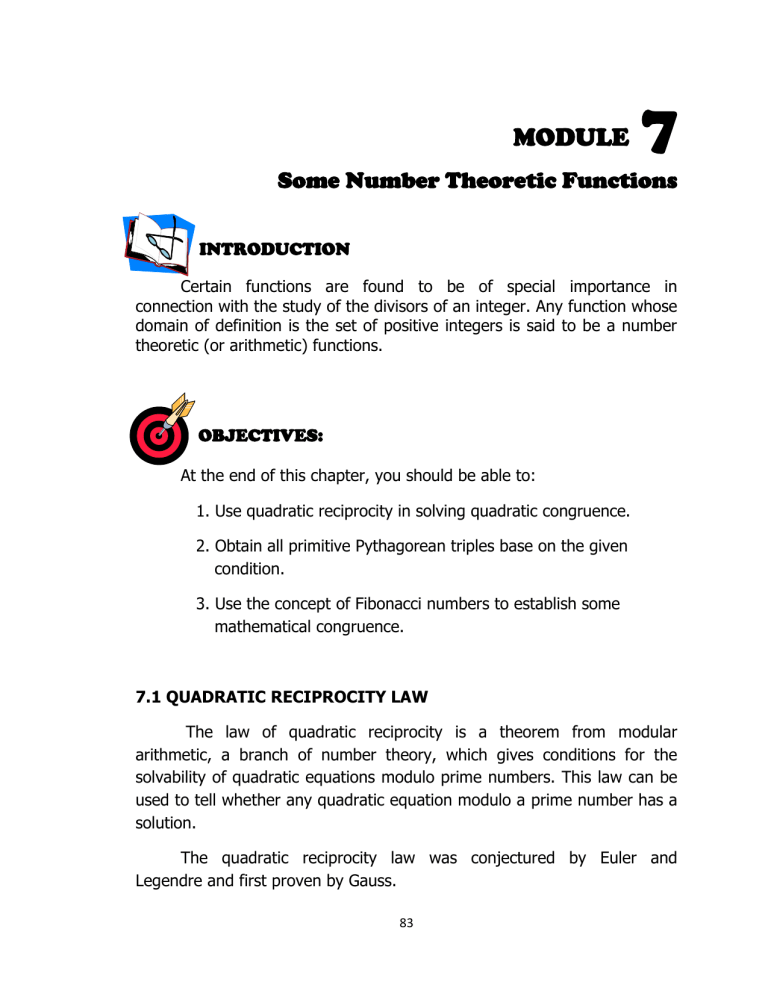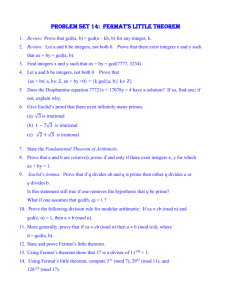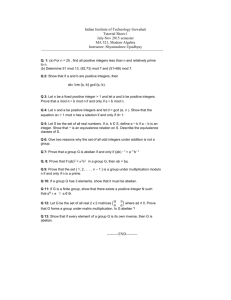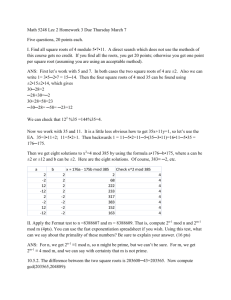Module 7 - CLSU Open University

MODULE
7
Some Number Theoretic Functions
INTRODUCTION
Certain functions are found to be of special importance in connection with the study of the divisors of an integer. Any function whose domain of definition is the set of positive integers is said to be a number theoretic (or arithmetic) functions.
OBJECTIVES:
At the end of this chapter, you should be able to:
1. Use quadratic reciprocity in solving quadratic congruence.
2. Obtain all primitive Pythagorean triples base on the given condition.
3. Use the concept of Fibonacci numbers to establish some mathematical congruence.
7.1 QUADRATIC RECIPROCITY LAW
The law of quadratic reciprocity is a theorem from modular arithmetic, a branch of number theory, which gives conditions for the solvability of quadratic equations modulo prime numbers. This law can be used to tell whether any quadratic equation modulo a prime number has a solution.
The quadratic reciprocity law was conjectured by Euler and
Legendre and first proven by Gauss.
83
Consider the congruence ax 2 + bx + c 0 (mod p) (1) where p is an odd prime and a 0 (mod p); that is, gcd(a, p) = 1. The supposition that p is an odd prime implies that gcd(4a, p) = 1. Thus, quadratic congruence (1) is equivalent to
4a(ax 2 + bx + c) 0 (mod p)
By using the identity
4a(ax 2 + bx + c) = (2ax + b) 2 – (b 2 – 4ac),
The last written quadratic congruence may be expressed as
(2ax + b) 2 (b 2 – 4ac) (mod p).
Now put y = 2ax + b and d = b 2 – 4ac to get y 2 d(mod p) (2)
If x x
0
(mod p) is a solution of quadratic congruence(1), then the integer y 2ax
0
+ b (mod p) satisfies quadratic congruence(2).Conversely, if y y
0
(mod p) is a solution of quadratic congruence(2), then 2ax y
0
– b( mod p) can be solved to obtain a solution of (1).
Thus, the problem of finding a solution to the quadratic congruence(1) is equivalent to that of finding a solution to a linear congruence and a quadratic congruence of the form
x 2 a(mod p) (3)
If p a, then quadratic congruence(3) has x 0(mod p) as its only solution.
To avoid trivialities, let us agree to assume hereafter that p a.
84
Example 1.
Solve the quadratic congruence 5x 2 – 6x + 2 0(mod 13).
Solution:
Solving for d, we have d = b 2 – 4ac = (-6) 2 – 4(5)(2) d = 36 – 40 d = - 4
To obtain the solution, one replaces this congruence by the simpler one y 2 - 4(mod 13) or y 2 9(mod 13)
If y 2 - 4(mod 13) or y 2 9(mod 13) then, y 3(mod 13) and y - 3(mod 13) or y 10 (mod 13). y = 2ax + b
3 = 2(5)x – 6 y = 2ax + b
-3 = 2(5)x – 6 y = 2ax + b
10 = 2(5)x - 6
9 = 10x
10x 9(mod 13)
x = 10
3 = 10x 16 = 10x
10x 3(mod 13) 10x 16(mod 13)
x = 12 x = 12
Let p be an odd prime and gcd(a, p) = 1. If the congruence x 2 a
(mod p) has a solution, then a is said to be a quadratic residue of p.
Otherwise, a is called a quadratic non-residue of p.
85
Example 2.
Let p =13, find how many of the integers 1, 2, 3, ... 12 are quadratic residues of 13.
Solution:
To find out how many of the integers are quadratic residues of 13, we must know which of the congruences x 2 a (mod 13) are solvable when a runs through the set { 1, 2, 3, ... 12} Modulo 13.
The squares of the integers 1, 2, 3, ... 12 are
1 2 12 2 1,
2 2 11 2 4,
3 2 10 2 9,
4 2 9 2 3,
5 2 8 2 12,
6 2 7 2 10.
Consequently, the quadratic residues of 13 are 1, 3, 4, 9, 10, 12 while the non-residues are 2, 5, 6, 7, 8, 11. Observe that the integers between 1 and 12 are divided equally among the quadratic residues and non-residues.
SCQ1:
Find all odd primes p for which 2 and 3 are quadratic residues.
86
Activity 7.1
1.
Solve the following quadratic congruences. a.
x 2 + 7x + 10 0(mod 11) b.
3x 2 + 9x + 7 0(mod 13) c.
5x 2 + 6x +1 0(mod 23)
2.
Find the quadratic residues and quadratic non-residues of the following odd prime number. a.
p = 17 b.
p = 23 c.
p = 31
87
7. 2 PYTHAGOREAN TRIPLES
A pythagorean triples is an ordered triple (x, y, z) of three positive integers such that x 2 + y 2 = z 2 . If x, y, and z are relatively prime, then the triple is called primitive.
Illustrations:
a.
3, 4, 5 b. 5, 12, 13 c. 12, 35, 37
Suppose that x, y, z is any Pythagorean triple and d = gcd(x, y, z).
If we write x = dx
1
, y = dy
1
, z = dz
1
, then it is easily seen that
𝑥
1
2 + 𝑦
1
2 = 𝑥 2 + 𝑦 2 𝑑 2 𝑧 2
= 𝑑 2
= 𝑧
1
2
With gcd(x
1
, y
1
, z
1
) = 1. In short, x
1
, y
1
, z
1
form a primitive triple.
Lemma:
If x, y, z is a primitive pythagorean triple, then one of the integers x and y is even while the other is odd.
Proof:
If x and y are both even, then 2 (x 2 + y 2 ) or 2 z 2 , so that 2 z. The inference is that gcd(x, y, z) ≥ 2, which we know to be false. If, on the other hand, x and y should be both odd, then x 2 1(mod 4) and y 2
1(mod 4), leading to z 2 = x 2 + y 2 2(mod 4).
But this is equally impossible, since the square of any integer must be congruent either to 0 or to 1 modulo 4.
Given a primitive Pythagorean triple x, y, z exactly one of these integers is even, the other two being odd. The foregoing lemma indicates that the even integer is either x or y; to be definite, we shall hereafter write our
Pythagorean triples so that x is even and y is odd; then of course, z is odd.
88
It is worth noticing that each pair of integers x, y and z must be relatively prime. Where in the case that gcd(x, y) = d > 1, then there would exist a prime p with p d. Since, d x and d y, we would have p x and p y, whence p x 2 and p y 2 . But then p (x 2 + y 2 ), or p z 2 , giving p z. This would conflict with the assumption that gcd(x, y, z) = 1, and so d = 1. In like manner, one can verify that gcd(y, z) = gcd(x, z) = 1.
By the virtue of Lemma, there exist no primitive Pythagorean triple x, y, z all of whose values are prime numbers.
Theorem 7-1
All solutions of the pythagorean equation x 2 + y 2 = z 2 satisfying the conditions gcd(x, y, z) = 1, 2 x , x > 0, y > 0, z > 0 are given by the formulas x = 2st, y = s 2 – t 2 , z = s 2 + t 2 for integers s > t > 0 such that gcd(s, t) = 1 and s t(mod 2).
Proof:
(left as an exercise)
89
The table below lists some primitive Pythagorean triples arising from small values of s and t. For each value of s = 1, 2, 3, 4, . . ., 7, , we have taken those values of t which are relatively prime to s, less than s, and even whenever s is odd.
6
7
7
4
5
5
6
7
S
2
3
4
5
2
4
3
2
4
1
6 t
1
2
1
24
20
40
12
60
28
56
84 x
(2st)
4
12
8 y
(s 2 – t 2 )
3
5
15
7
21
9
35
11
45
13
13
Z
(s 2 + t 2 )
5
13
17
25
29
41
37
61
53
85
85
From this, or from a more extensive table, we might lead to suspect that if x, y, z is a primitive Pythagorean triple, then exactly one of the integers x or y is divisible by 3. This is, in fact, the case. For we have x = 2st y = s 2 - t 2 z = s 2 + t 2 where gcd(s, t) = 1. If either 3 s or 3 t, then evidently 3 x, and we need go no farther. Suppose that 3 does not divide s and 3 does not divide t.
Fermat’s theorem asserts that s 2 1(mod 3), t 2 1(mod 3) and so y = s 2 – t 2 0(mod 3)
In other words, y is divisible by 3, which is what we are required to show.
90
1.
Find three Pythagorean triples, not necessarily primitive, of the form
12, y, z.
2.
Obtain all primitive Pythagorean triples x, y, z in which x = 40.
3.
If x, y, z is a primitive Pythagorean triple, prove that x + y and x – y are congruent modulo 8 to either 1 or 7.
4.
Complete the table of primitive Pythagorean triples.
S
4
5
7 t
5
2 x
24 y
11
13
Z
41
53
91
7.3 FIBONACCI NUMBERS
The Fibonacci numbers in mathematics is a series of numbers in which each member is the sum of the two preceding numbers. The series was discovered by the Italian mathematician Leonardo Fibonacci. Fibonacci numbers have many interesting properties and are widely used in mathematics especially in number theory.
Fibonacci is remembered today mainly because the 19 th century number theorist Edouard Lucas attached his name to a sequence that appears in a trivial problem in the
Liber Abaci
. Specifically, Fibonacci posed the following problem dealing with the number of off-spring generated by a pair of rabbits conjured up in the imagination.
“Assuming that none of the rabbits dies, then a pair is born during the first month, so that there are two pairs present. During the second month, the original pair has produced another pair. One month later, both the original pair and the firstborn pair have produced new pairs,, so that three adult and two young pairs are present, and so on.” The point to bear in mind is that each month the young pairs grow up and become adult pairs, making the new “adult” entry the previous one plus the previous “young” entry.
Each of the pairs that was adult last month produces one young pair, so that the new “ young” entry is equal to the previous “ adult” entry.
When continued indefinitely, the sequence encountered in the rabbit problem 1, 1, 2, 3, 5, 8, 13, 21, 34, 55, 89, 144, 233, 377, . . . is called the
Fibonacci sequence
and its terms the
Fibonacci numbers
. The position of each number in this sequence is traditionally indicated by a subscript, so that u
1
= 1, u
2
= 1, u
3
= 2, u
4
= 3, u
5
= 5, u
6
= 8, and so forth, with u n denoting the nth Fibonacci number.
92
Growth of Rabbit Colony
Months
1
2
3
4
5
6
7
8
9
10
11
12
Adult Pairs
1
2
3
5
8
13
21
34
55
89
144
233
Young Pairs
1
1
2
3
5
8
13
21
34
55
89
144
Total
2
3
5
8
13
21
34
55
89
144
233
377
The Fibonacci sequence exhibits an intriguing property, namely,
2 = 1 + 1 or u
3
= u
2
+ u
1
,
3 = 2 + 1 or u
4
= u
3
+ u
2
,
5 = 3 + 2 or u
5
= u
4
+ u
3
,
8 = 5 + 3 or u
6
= u
5
+ u
4.
By observation, the general rule of formulation should be: u n
= u n-1
+ u n-2 for n 3 and u
1
= u
2
= 1
Theorem 7-2
For the Fibonacci sequence, gcd(u n
, u n+1
) = 1 for every n 1.
Proof:
Let us suppose that the integer d > 1 divides both u n
and u n+1
. Then their difference u n+1
– u n
= u n-1
will also be divisible by d. From this and from the relation u n
- u n-1
= u n-2
, it may be concluded that d u n-2
. Working backward, the same argument shows that d u n-3
, d u n-4
, . . ., and finally
93
that d u
1
. But u
1
= 1, which is certainly not divisible by any d > 1. This contradiction ends our proof.
Theorem 7-3
For m 1 , n 1, u mn is divisible by u m
.
Proof:
(left as an exercise)
Illustration:
Let u m
= 2 and u n
= 3 u mn
= u
(2)(3)
= u
6
= 8
From these values we see that u mn
is divisible by u m
or 8 is divisible by 2.
Theorem 7-4
The greatest common divisor of two fibinacci numbers is again a
Fibonacci number; specifically. gcd(u m
, u n
) = u d
, where u d
= gcd(m, n)
Proof:
(left as an exercise)
Example:
Find the greatest common divisor of u
16
and u
12
.
Solution: gcd(u
16
, u
12
) = gcd(987, 144)
From the Euclidean Algorithm,
987 = 144(6) + 123
144 = 123(1) + 21
94
123 = 21(5) + 18
21 = 18(1) + 3
18 = 3(6) + 0 and so gcd(987, 144) = gcd(u
16
, u
12
) = 3
Another method of finding the greatest common divisor of u
16
and u
12
is by applying the theorem. gcd(u
16
, u
12
) = u d
where d = gcd(16, 12) = d = 4 gcd(u
16
, u
12
) = u
4 gcd(u
16
, u
12
) = 3
SCQ2:
Write the first ten terms of the Fibonacci series. Prove in general that any two consecutive terms are relatively prime.
95
Activity 7.3
1.
Evaluate the following using Fibonacci numbers. a.
gcd(u
9
, u
12
) b.
gcd(u
15
, u
20
) c.
gcd(u
24
, u
36
)
2.
Find the Fibonacci numbers which divide both u
24
and u
36
.
3.
For the Fibonacci sequence, establish that a.
u n+3
u n
(mod 2), hence u
3
, u
6
, u
9
, . . . are all even integers b.
u n+5
3u n
(mod 5), hence u
5
, u
10
, u
15
, . . . are all divisible by 5
4.
Use induction to show that u
2n
n(-1) n+1 (mod 5) for n 1.
96









